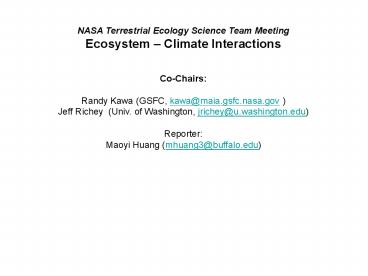NASA Terrestrial Ecology Science Team Meeting - PowerPoint PPT Presentation
Title:
NASA Terrestrial Ecology Science Team Meeting
Description:
Maoyi Huang (mhuang3_at_buffalo.edu) 1. What are the most important and compelling research questions / science ... Predicative Ag-focused landuse model ... – PowerPoint PPT presentation
Number of Views:60
Avg rating:3.0/5.0
Title: NASA Terrestrial Ecology Science Team Meeting
1
NASA Terrestrial Ecology Science Team
Meeting Ecosystem Climate Interactions
Co-Chairs Randy Kawa (GSFC,
kawa_at_maia.gsfc.nasa.gov ) Jeff Richey (Univ. of
Washington, jrichey_at_u.washington.edu) Reporter M
aoyi Huang (mhuang3_at_buffalo.edu)
2
1. What are the most important and compelling
research questions / science issues in this
thematic area for NASAs Terrestrial Ecology
Program to address next? (and Why?)
- Theory/practice focus
- Thresholds/ step functions/ non-linearity,
tipping points - Ecosystem dynamics/resilience to climate forcing,
especially extreme events as represented in
regional and global models - Geography scaling
- Regional Need for and how to do higher
resolution ecosystem dynamics lt-gt climate at
(specific) regional scales, - higher/multiple temporal resolutions
(identification of specific regions). - regions unto themselves.
- Greater biome specificity especially
agriculture/climate - Track precipitation/surface climate - ecosystem
interactions -gt runoff (to ocean) regimes - Global how to achieve it(still disconnect)is
it sum of inter-connected regions (complementing
just finer grids)?? - System Uncertainty/variance model
(intercomparisons, parameters go into it)
3
2. What are the key remote sensing data records
(time series products, CDRs, ESDRs) required to
address these research questions /science issues?
(and Why / How will they be used?)?
Commensurate in scale with high resolution
regional studies focus on integrated records
to make best product
Land Surface Dynamics Properties (LAI, NDVI/,
EVI, albedo, fPAR (AVHRR, MODIS, SEAWIFS) -
still key
CDR Consistent Surface Climate Forcing Time
Series 1 Precipitation!!!! (All NCEP,
regional met records, TRMM) 2 Surface
temperature, Rn
ESDR - 1. Global estimate of wood biomass
integrated data sets (land history, radar, lidar,
optical) for model initialization 2. Agriculture
parameters albedo by crops, irrigation,
phenology, soil water etc) (including from ag
literature), 3. Landuse/disturbance history 4.
Rooting depths by geography/vegetation types
Soil moisture, freeze/thaw microwave
(AMSR?)/GRACE groundwater
4
3. What new measurements (from Decadal Survey
missions and other satellite missions) will be
used to address these research questions /
science issues? (and Why / How will they be used?)
What should TE role be in these missions, to make
products?
Essential continuity perspectives (including
calibration)
LDCM top priority continuity - for LULC water
properties
MODIS Continuity (NPOESS)
Improving functionality of regional analyses
models
Time series record of Carbon, fluxes OCO,
ASCENDS (calibration w/records issues)
Hydrology/geochem SMAP 5cm soil moisture for
physiology, models in low structure regions
SWOT improve hydrology, for models (GEO-CAPE)
Structure and biomass DESDynI, ICESAT-II, LIST
Biogeochem, Hyperspectral veg function HyspIRI
Airborne (manned, UAVs)
Recognition of non-NASA instruments
5
4. What else will be needed (e.g., supporting
research and technology investments, field
studies, model development, cal/val) to achieve
the NASA scientific objectives for this theme?
Field Campaign Problem-focused by geomorphology
ecoregion-based Land-ocean N. High
latitude/permafrost Tropical monsoon Threshold
drought Agriculture-intensive
- Model Activities
- Large-scale model paradigm shifts flexible
grids in global models - Model uncertainty
- More model data inter-comparisons including
international - Flexible grid for landscape/hydrology models for
near-water (and routing) - Predicative Ag-focused landuse model
- Geographical information/high resolution for
coupled atmosphere/landsurface models - Expand data assimilation, from CO2 e.g.
constituents, tree rings, atm chem - Carbon inversions
6
5. What is needed to support this theme from
other themes in the NASA Terrestrial Ecology
Program and how should it be done?
All of the above































